Cinema and Literature: An In-Depth Analysis of The Matrix Trilogy
VerifiedAdded on 2020/05/11
|39
|9559
|51
Essay
AI Summary
This research paper delves into the science fiction films of Lana and Lily Wachowski, with a primary focus on The Matrix trilogy. The paper examines the filmmakers' interpretation of scientific, philosophical, and spiritual theories, demonstrating how they crafted a new language of science fiction. It critically analyzes the films and other works to identify thematic connections and their contributions to cinema, while acknowledging the tendency to combine diverse aspects, sometimes leading to misinterpretations. The paper argues that the Wachowskis innovatively remediated pre-existing forms and techniques, making their works ahead of their time. The study explores themes such as post-modernism, cognitive dissonance, social penetration, social identity, and the influence of The Matrix on other sci-fi films. It also analyzes the philosophical underpinnings, including hyperreality, Marxist propaganda, and religious references. The paper concludes with an argument on the Wachowskis' style, their works, and the remediation and premediation within The Matrix trilogy, drawing inspiration from various sources like Japanese animation, video games, and Hindu mythology.
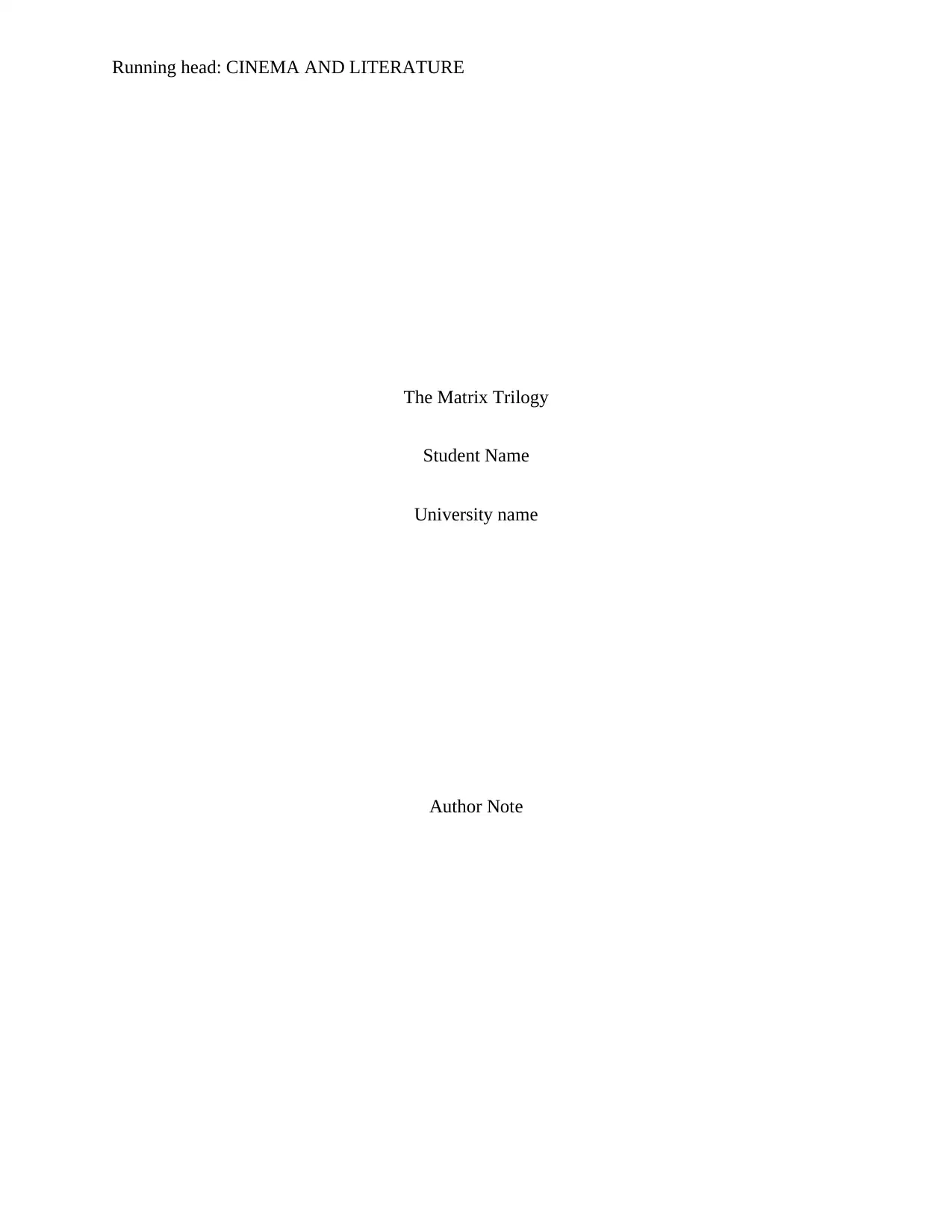
Running head: CINEMA AND LITERATURE
The Matrix Trilogy
Student Name
University name
Author Note
The Matrix Trilogy
Student Name
University name
Author Note
Paraphrase This Document
Need a fresh take? Get an instant paraphrase of this document with our AI Paraphraser
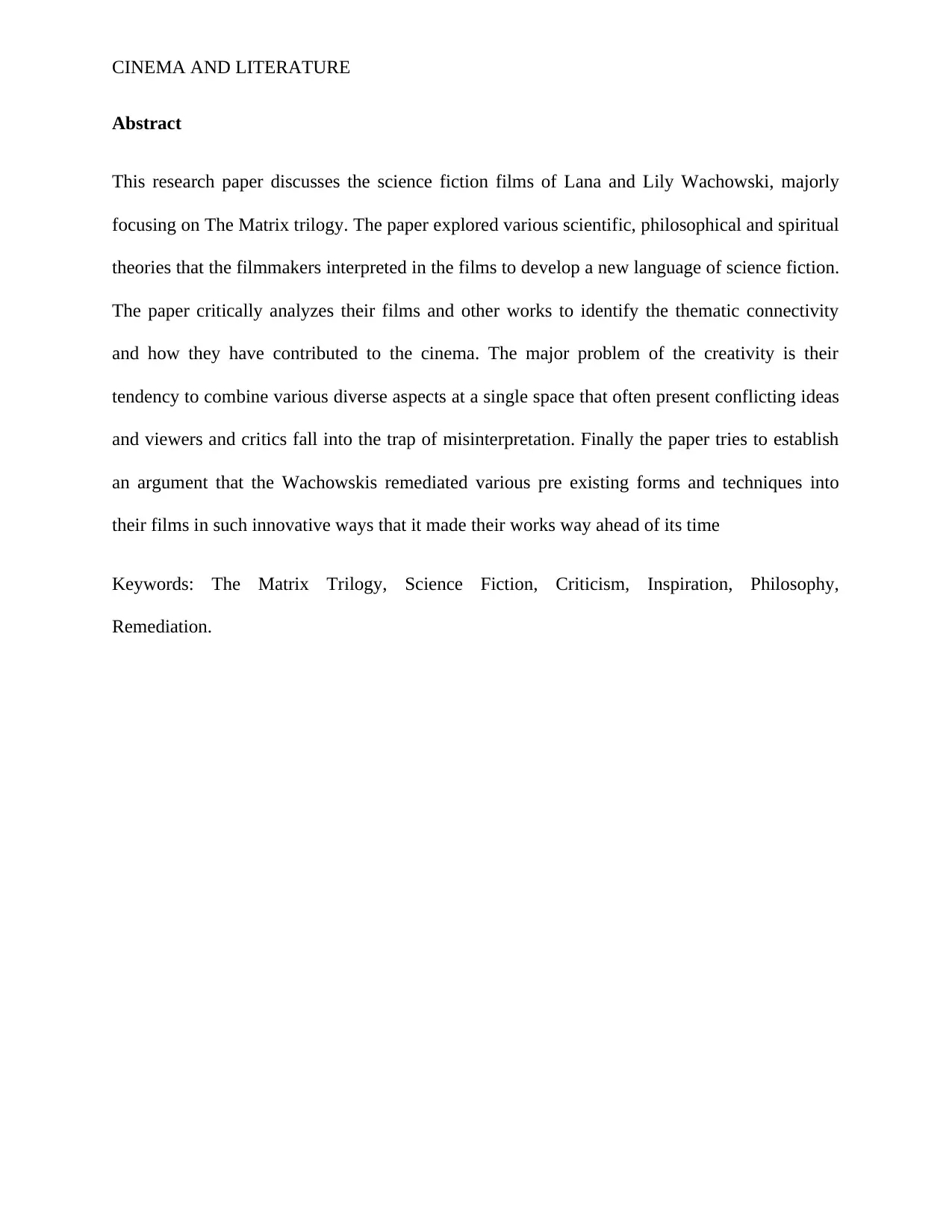
CINEMA AND LITERATURE
Abstract
This research paper discusses the science fiction films of Lana and Lily Wachowski, majorly
focusing on The Matrix trilogy. The paper explored various scientific, philosophical and spiritual
theories that the filmmakers interpreted in the films to develop a new language of science fiction.
The paper critically analyzes their films and other works to identify the thematic connectivity
and how they have contributed to the cinema. The major problem of the creativity is their
tendency to combine various diverse aspects at a single space that often present conflicting ideas
and viewers and critics fall into the trap of misinterpretation. Finally the paper tries to establish
an argument that the Wachowskis remediated various pre existing forms and techniques into
their films in such innovative ways that it made their works way ahead of its time
Keywords: The Matrix Trilogy, Science Fiction, Criticism, Inspiration, Philosophy,
Remediation.
Abstract
This research paper discusses the science fiction films of Lana and Lily Wachowski, majorly
focusing on The Matrix trilogy. The paper explored various scientific, philosophical and spiritual
theories that the filmmakers interpreted in the films to develop a new language of science fiction.
The paper critically analyzes their films and other works to identify the thematic connectivity
and how they have contributed to the cinema. The major problem of the creativity is their
tendency to combine various diverse aspects at a single space that often present conflicting ideas
and viewers and critics fall into the trap of misinterpretation. Finally the paper tries to establish
an argument that the Wachowskis remediated various pre existing forms and techniques into
their films in such innovative ways that it made their works way ahead of its time
Keywords: The Matrix Trilogy, Science Fiction, Criticism, Inspiration, Philosophy,
Remediation.
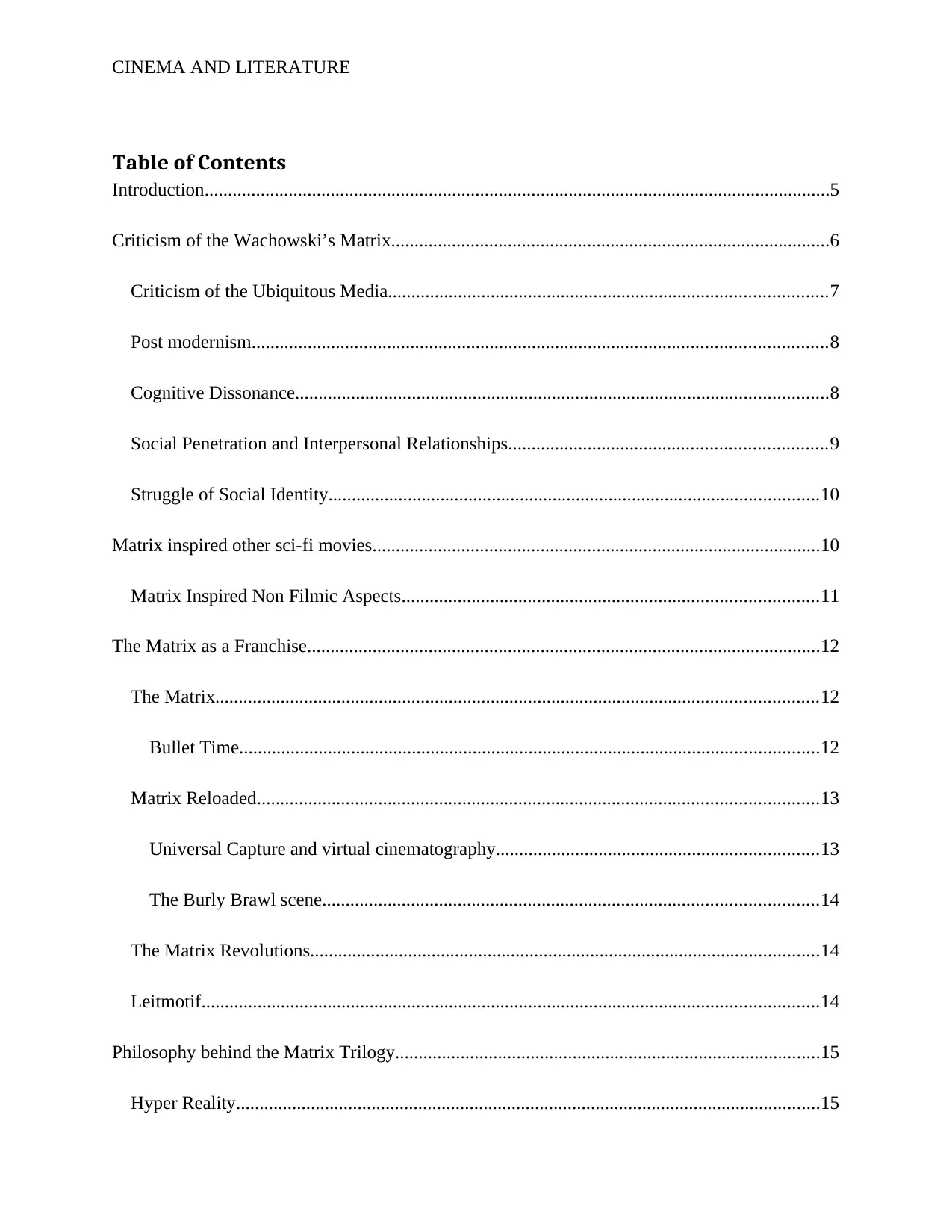
CINEMA AND LITERATURE
Table of Contents
Introduction......................................................................................................................................5
Criticism of the Wachowski’s Matrix..............................................................................................6
Criticism of the Ubiquitous Media..............................................................................................7
Post modernism...........................................................................................................................8
Cognitive Dissonance..................................................................................................................8
Social Penetration and Interpersonal Relationships....................................................................9
Struggle of Social Identity.........................................................................................................10
Matrix inspired other sci-fi movies................................................................................................10
Matrix Inspired Non Filmic Aspects.........................................................................................11
The Matrix as a Franchise..............................................................................................................12
The Matrix.................................................................................................................................12
Bullet Time............................................................................................................................12
Matrix Reloaded........................................................................................................................13
Universal Capture and virtual cinematography.....................................................................13
The Burly Brawl scene..........................................................................................................14
The Matrix Revolutions.............................................................................................................14
Leitmotif....................................................................................................................................14
Philosophy behind the Matrix Trilogy...........................................................................................15
Hyper Reality.............................................................................................................................15
Table of Contents
Introduction......................................................................................................................................5
Criticism of the Wachowski’s Matrix..............................................................................................6
Criticism of the Ubiquitous Media..............................................................................................7
Post modernism...........................................................................................................................8
Cognitive Dissonance..................................................................................................................8
Social Penetration and Interpersonal Relationships....................................................................9
Struggle of Social Identity.........................................................................................................10
Matrix inspired other sci-fi movies................................................................................................10
Matrix Inspired Non Filmic Aspects.........................................................................................11
The Matrix as a Franchise..............................................................................................................12
The Matrix.................................................................................................................................12
Bullet Time............................................................................................................................12
Matrix Reloaded........................................................................................................................13
Universal Capture and virtual cinematography.....................................................................13
The Burly Brawl scene..........................................................................................................14
The Matrix Revolutions.............................................................................................................14
Leitmotif....................................................................................................................................14
Philosophy behind the Matrix Trilogy...........................................................................................15
Hyper Reality.............................................................................................................................15
⊘ This is a preview!⊘
Do you want full access?
Subscribe today to unlock all pages.

Trusted by 1+ million students worldwide
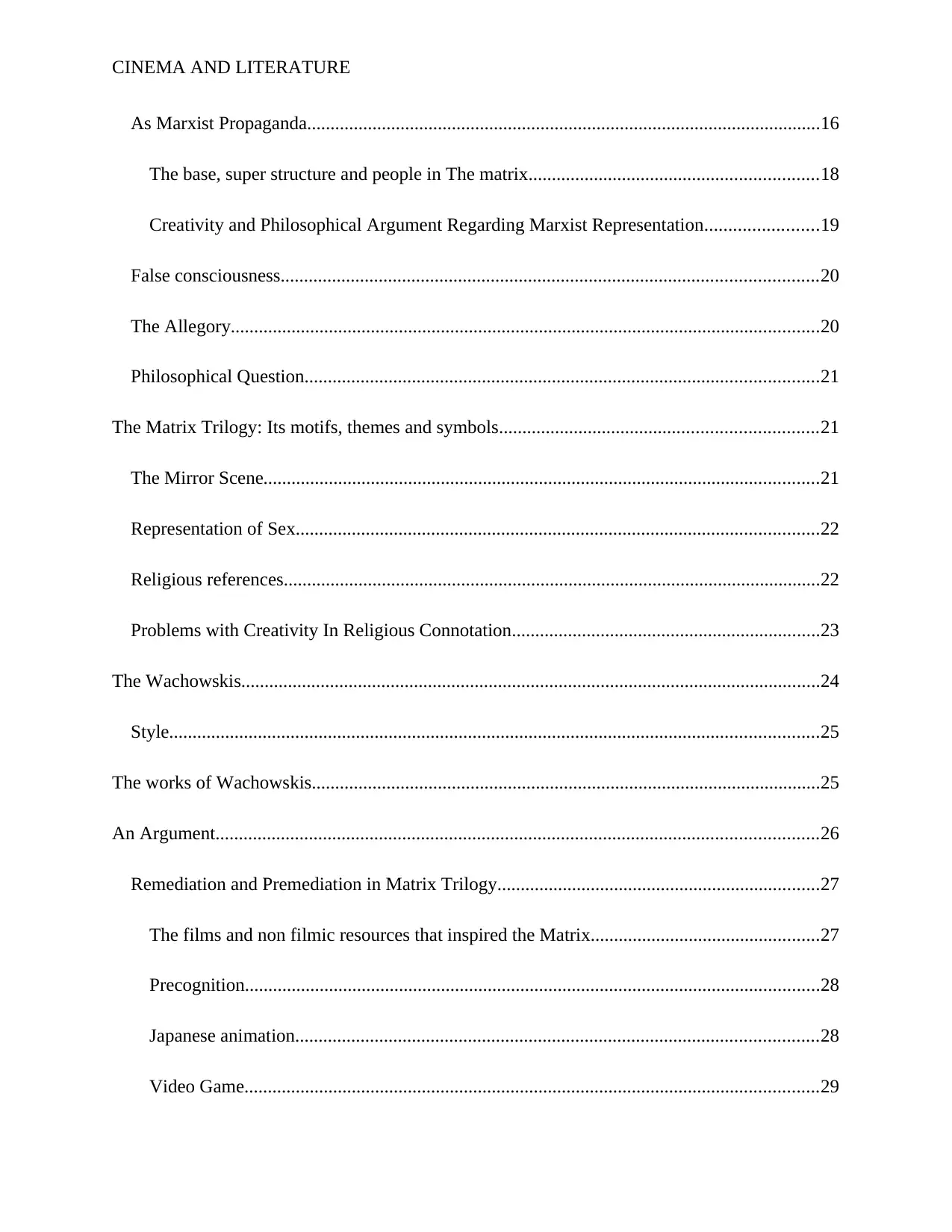
CINEMA AND LITERATURE
As Marxist Propaganda..............................................................................................................16
The base, super structure and people in The matrix..............................................................18
Creativity and Philosophical Argument Regarding Marxist Representation........................19
False consciousness...................................................................................................................20
The Allegory..............................................................................................................................20
Philosophical Question..............................................................................................................21
The Matrix Trilogy: Its motifs, themes and symbols....................................................................21
The Mirror Scene.......................................................................................................................21
Representation of Sex................................................................................................................22
Religious references...................................................................................................................22
Problems with Creativity In Religious Connotation..................................................................23
The Wachowskis............................................................................................................................24
Style...........................................................................................................................................25
The works of Wachowskis.............................................................................................................25
An Argument.................................................................................................................................26
Remediation and Premediation in Matrix Trilogy.....................................................................27
The films and non filmic resources that inspired the Matrix.................................................27
Precognition...........................................................................................................................28
Japanese animation................................................................................................................28
Video Game...........................................................................................................................29
As Marxist Propaganda..............................................................................................................16
The base, super structure and people in The matrix..............................................................18
Creativity and Philosophical Argument Regarding Marxist Representation........................19
False consciousness...................................................................................................................20
The Allegory..............................................................................................................................20
Philosophical Question..............................................................................................................21
The Matrix Trilogy: Its motifs, themes and symbols....................................................................21
The Mirror Scene.......................................................................................................................21
Representation of Sex................................................................................................................22
Religious references...................................................................................................................22
Problems with Creativity In Religious Connotation..................................................................23
The Wachowskis............................................................................................................................24
Style...........................................................................................................................................25
The works of Wachowskis.............................................................................................................25
An Argument.................................................................................................................................26
Remediation and Premediation in Matrix Trilogy.....................................................................27
The films and non filmic resources that inspired the Matrix.................................................27
Precognition...........................................................................................................................28
Japanese animation................................................................................................................28
Video Game...........................................................................................................................29
Paraphrase This Document
Need a fresh take? Get an instant paraphrase of this document with our AI Paraphraser

CINEMA AND LITERATURE
Hindu Mythology...................................................................................................................30
Conclusion.....................................................................................................................................30
Bibliography..................................................................................................................................32
Hindu Mythology...................................................................................................................30
Conclusion.....................................................................................................................................30
Bibliography..................................................................................................................................32
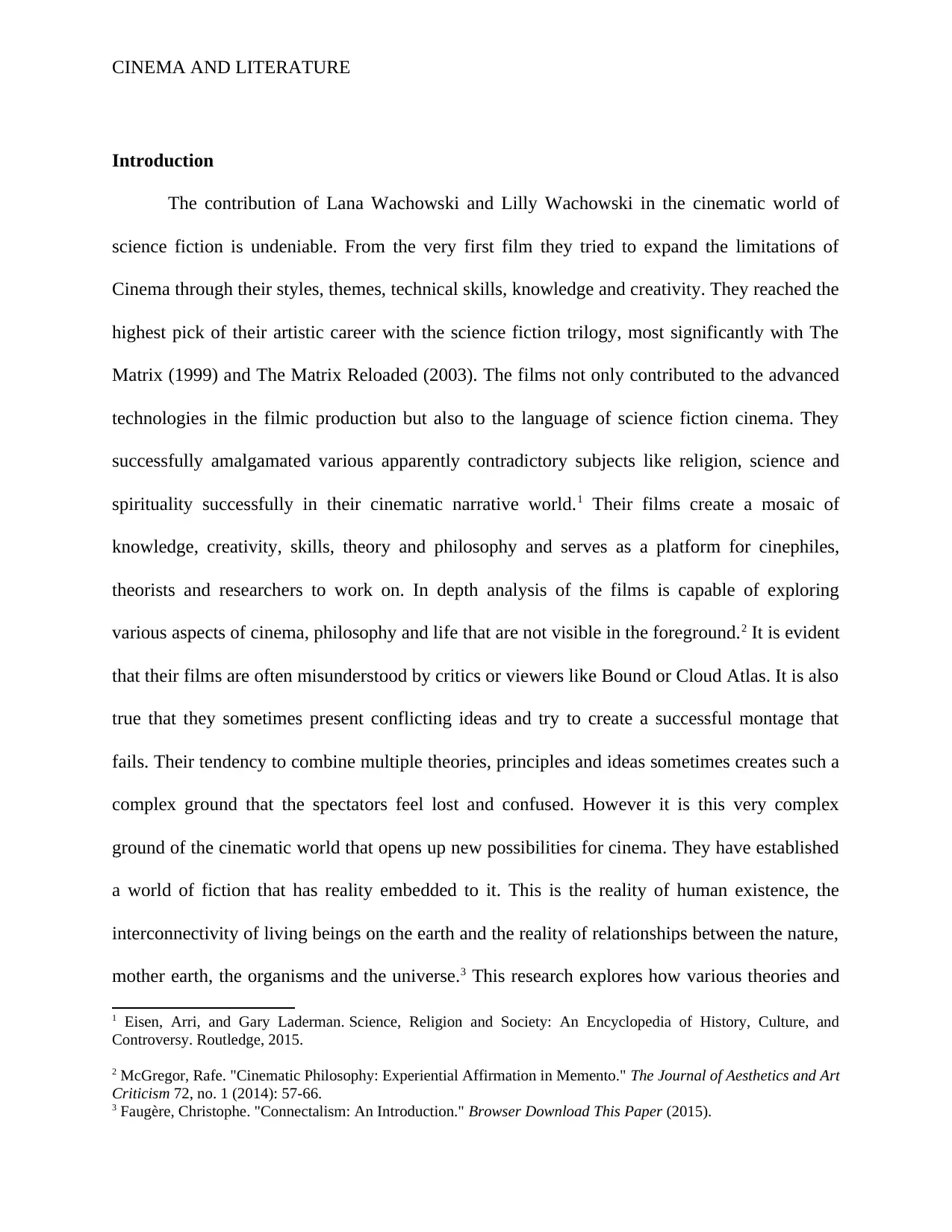
CINEMA AND LITERATURE
Introduction
The contribution of Lana Wachowski and Lilly Wachowski in the cinematic world of
science fiction is undeniable. From the very first film they tried to expand the limitations of
Cinema through their styles, themes, technical skills, knowledge and creativity. They reached the
highest pick of their artistic career with the science fiction trilogy, most significantly with The
Matrix (1999) and The Matrix Reloaded (2003). The films not only contributed to the advanced
technologies in the filmic production but also to the language of science fiction cinema. They
successfully amalgamated various apparently contradictory subjects like religion, science and
spirituality successfully in their cinematic narrative world.1 Their films create a mosaic of
knowledge, creativity, skills, theory and philosophy and serves as a platform for cinephiles,
theorists and researchers to work on. In depth analysis of the films is capable of exploring
various aspects of cinema, philosophy and life that are not visible in the foreground.2 It is evident
that their films are often misunderstood by critics or viewers like Bound or Cloud Atlas. It is also
true that they sometimes present conflicting ideas and try to create a successful montage that
fails. Their tendency to combine multiple theories, principles and ideas sometimes creates such a
complex ground that the spectators feel lost and confused. However it is this very complex
ground of the cinematic world that opens up new possibilities for cinema. They have established
a world of fiction that has reality embedded to it. This is the reality of human existence, the
interconnectivity of living beings on the earth and the reality of relationships between the nature,
mother earth, the organisms and the universe.3 This research explores how various theories and
1 Eisen, Arri, and Gary Laderman. Science, Religion and Society: An Encyclopedia of History, Culture, and
Controversy. Routledge, 2015.
2 McGregor, Rafe. "Cinematic Philosophy: Experiential Affirmation in Memento." The Journal of Aesthetics and Art
Criticism 72, no. 1 (2014): 57-66.
3 Faugère, Christophe. "Connectalism: An Introduction." Browser Download This Paper (2015).
Introduction
The contribution of Lana Wachowski and Lilly Wachowski in the cinematic world of
science fiction is undeniable. From the very first film they tried to expand the limitations of
Cinema through their styles, themes, technical skills, knowledge and creativity. They reached the
highest pick of their artistic career with the science fiction trilogy, most significantly with The
Matrix (1999) and The Matrix Reloaded (2003). The films not only contributed to the advanced
technologies in the filmic production but also to the language of science fiction cinema. They
successfully amalgamated various apparently contradictory subjects like religion, science and
spirituality successfully in their cinematic narrative world.1 Their films create a mosaic of
knowledge, creativity, skills, theory and philosophy and serves as a platform for cinephiles,
theorists and researchers to work on. In depth analysis of the films is capable of exploring
various aspects of cinema, philosophy and life that are not visible in the foreground.2 It is evident
that their films are often misunderstood by critics or viewers like Bound or Cloud Atlas. It is also
true that they sometimes present conflicting ideas and try to create a successful montage that
fails. Their tendency to combine multiple theories, principles and ideas sometimes creates such a
complex ground that the spectators feel lost and confused. However it is this very complex
ground of the cinematic world that opens up new possibilities for cinema. They have established
a world of fiction that has reality embedded to it. This is the reality of human existence, the
interconnectivity of living beings on the earth and the reality of relationships between the nature,
mother earth, the organisms and the universe.3 This research explores how various theories and
1 Eisen, Arri, and Gary Laderman. Science, Religion and Society: An Encyclopedia of History, Culture, and
Controversy. Routledge, 2015.
2 McGregor, Rafe. "Cinematic Philosophy: Experiential Affirmation in Memento." The Journal of Aesthetics and Art
Criticism 72, no. 1 (2014): 57-66.
3 Faugère, Christophe. "Connectalism: An Introduction." Browser Download This Paper (2015).
⊘ This is a preview!⊘
Do you want full access?
Subscribe today to unlock all pages.

Trusted by 1+ million students worldwide
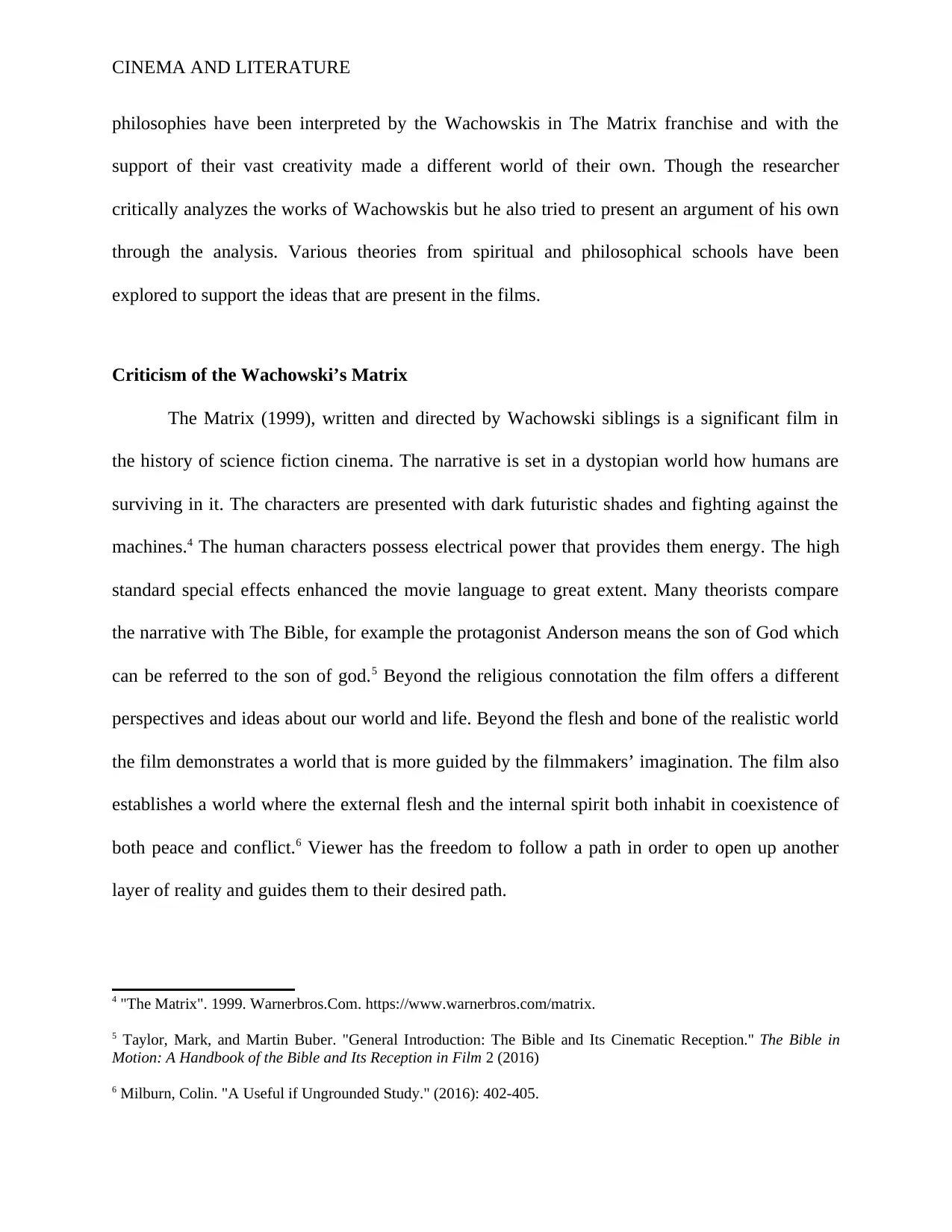
CINEMA AND LITERATURE
philosophies have been interpreted by the Wachowskis in The Matrix franchise and with the
support of their vast creativity made a different world of their own. Though the researcher
critically analyzes the works of Wachowskis but he also tried to present an argument of his own
through the analysis. Various theories from spiritual and philosophical schools have been
explored to support the ideas that are present in the films.
Criticism of the Wachowski’s Matrix
The Matrix (1999), written and directed by Wachowski siblings is a significant film in
the history of science fiction cinema. The narrative is set in a dystopian world how humans are
surviving in it. The characters are presented with dark futuristic shades and fighting against the
machines.4 The human characters possess electrical power that provides them energy. The high
standard special effects enhanced the movie language to great extent. Many theorists compare
the narrative with The Bible, for example the protagonist Anderson means the son of God which
can be referred to the son of god.5 Beyond the religious connotation the film offers a different
perspectives and ideas about our world and life. Beyond the flesh and bone of the realistic world
the film demonstrates a world that is more guided by the filmmakers’ imagination. The film also
establishes a world where the external flesh and the internal spirit both inhabit in coexistence of
both peace and conflict.6 Viewer has the freedom to follow a path in order to open up another
layer of reality and guides them to their desired path.
4 "The Matrix". 1999. Warnerbros.Com. https://www.warnerbros.com/matrix.
5 Taylor, Mark, and Martin Buber. "General Introduction: The Bible and Its Cinematic Reception." The Bible in
Motion: A Handbook of the Bible and Its Reception in Film 2 (2016)
6 Milburn, Colin. "A Useful if Ungrounded Study." (2016): 402-405.
philosophies have been interpreted by the Wachowskis in The Matrix franchise and with the
support of their vast creativity made a different world of their own. Though the researcher
critically analyzes the works of Wachowskis but he also tried to present an argument of his own
through the analysis. Various theories from spiritual and philosophical schools have been
explored to support the ideas that are present in the films.
Criticism of the Wachowski’s Matrix
The Matrix (1999), written and directed by Wachowski siblings is a significant film in
the history of science fiction cinema. The narrative is set in a dystopian world how humans are
surviving in it. The characters are presented with dark futuristic shades and fighting against the
machines.4 The human characters possess electrical power that provides them energy. The high
standard special effects enhanced the movie language to great extent. Many theorists compare
the narrative with The Bible, for example the protagonist Anderson means the son of God which
can be referred to the son of god.5 Beyond the religious connotation the film offers a different
perspectives and ideas about our world and life. Beyond the flesh and bone of the realistic world
the film demonstrates a world that is more guided by the filmmakers’ imagination. The film also
establishes a world where the external flesh and the internal spirit both inhabit in coexistence of
both peace and conflict.6 Viewer has the freedom to follow a path in order to open up another
layer of reality and guides them to their desired path.
4 "The Matrix". 1999. Warnerbros.Com. https://www.warnerbros.com/matrix.
5 Taylor, Mark, and Martin Buber. "General Introduction: The Bible and Its Cinematic Reception." The Bible in
Motion: A Handbook of the Bible and Its Reception in Film 2 (2016)
6 Milburn, Colin. "A Useful if Ungrounded Study." (2016): 402-405.
Paraphrase This Document
Need a fresh take? Get an instant paraphrase of this document with our AI Paraphraser
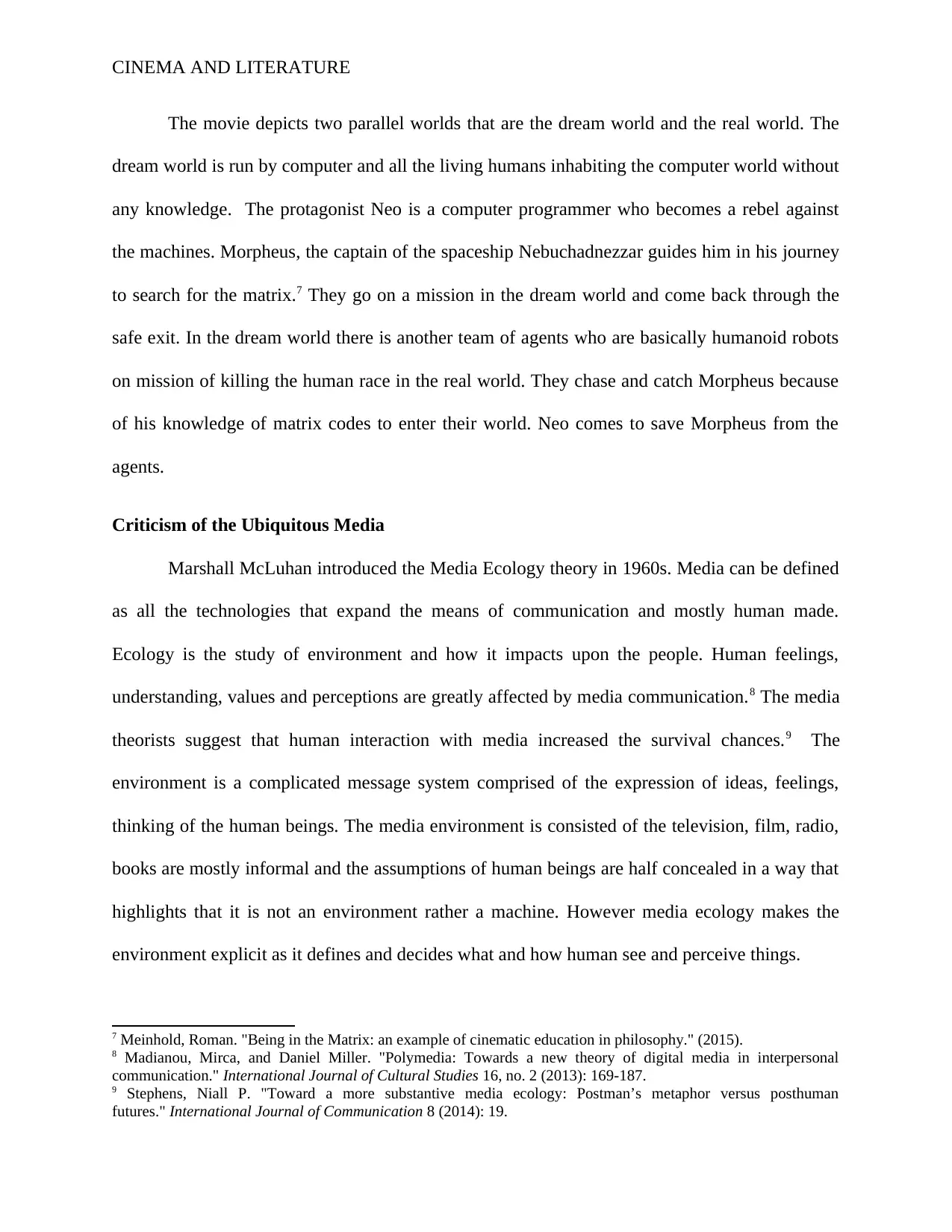
CINEMA AND LITERATURE
The movie depicts two parallel worlds that are the dream world and the real world. The
dream world is run by computer and all the living humans inhabiting the computer world without
any knowledge. The protagonist Neo is a computer programmer who becomes a rebel against
the machines. Morpheus, the captain of the spaceship Nebuchadnezzar guides him in his journey
to search for the matrix.7 They go on a mission in the dream world and come back through the
safe exit. In the dream world there is another team of agents who are basically humanoid robots
on mission of killing the human race in the real world. They chase and catch Morpheus because
of his knowledge of matrix codes to enter their world. Neo comes to save Morpheus from the
agents.
Criticism of the Ubiquitous Media
Marshall McLuhan introduced the Media Ecology theory in 1960s. Media can be defined
as all the technologies that expand the means of communication and mostly human made.
Ecology is the study of environment and how it impacts upon the people. Human feelings,
understanding, values and perceptions are greatly affected by media communication.8 The media
theorists suggest that human interaction with media increased the survival chances.9 The
environment is a complicated message system comprised of the expression of ideas, feelings,
thinking of the human beings. The media environment is consisted of the television, film, radio,
books are mostly informal and the assumptions of human beings are half concealed in a way that
highlights that it is not an environment rather a machine. However media ecology makes the
environment explicit as it defines and decides what and how human see and perceive things.
7 Meinhold, Roman. "Being in the Matrix: an example of cinematic education in philosophy." (2015).
8 Madianou, Mirca, and Daniel Miller. "Polymedia: Towards a new theory of digital media in interpersonal
communication." International Journal of Cultural Studies 16, no. 2 (2013): 169-187.
9 Stephens, Niall P. "Toward a more substantive media ecology: Postman’s metaphor versus posthuman
futures." International Journal of Communication 8 (2014): 19.
The movie depicts two parallel worlds that are the dream world and the real world. The
dream world is run by computer and all the living humans inhabiting the computer world without
any knowledge. The protagonist Neo is a computer programmer who becomes a rebel against
the machines. Morpheus, the captain of the spaceship Nebuchadnezzar guides him in his journey
to search for the matrix.7 They go on a mission in the dream world and come back through the
safe exit. In the dream world there is another team of agents who are basically humanoid robots
on mission of killing the human race in the real world. They chase and catch Morpheus because
of his knowledge of matrix codes to enter their world. Neo comes to save Morpheus from the
agents.
Criticism of the Ubiquitous Media
Marshall McLuhan introduced the Media Ecology theory in 1960s. Media can be defined
as all the technologies that expand the means of communication and mostly human made.
Ecology is the study of environment and how it impacts upon the people. Human feelings,
understanding, values and perceptions are greatly affected by media communication.8 The media
theorists suggest that human interaction with media increased the survival chances.9 The
environment is a complicated message system comprised of the expression of ideas, feelings,
thinking of the human beings. The media environment is consisted of the television, film, radio,
books are mostly informal and the assumptions of human beings are half concealed in a way that
highlights that it is not an environment rather a machine. However media ecology makes the
environment explicit as it defines and decides what and how human see and perceive things.
7 Meinhold, Roman. "Being in the Matrix: an example of cinematic education in philosophy." (2015).
8 Madianou, Mirca, and Daniel Miller. "Polymedia: Towards a new theory of digital media in interpersonal
communication." International Journal of Cultural Studies 16, no. 2 (2013): 169-187.
9 Stephens, Niall P. "Toward a more substantive media ecology: Postman’s metaphor versus posthuman
futures." International Journal of Communication 8 (2014): 19.
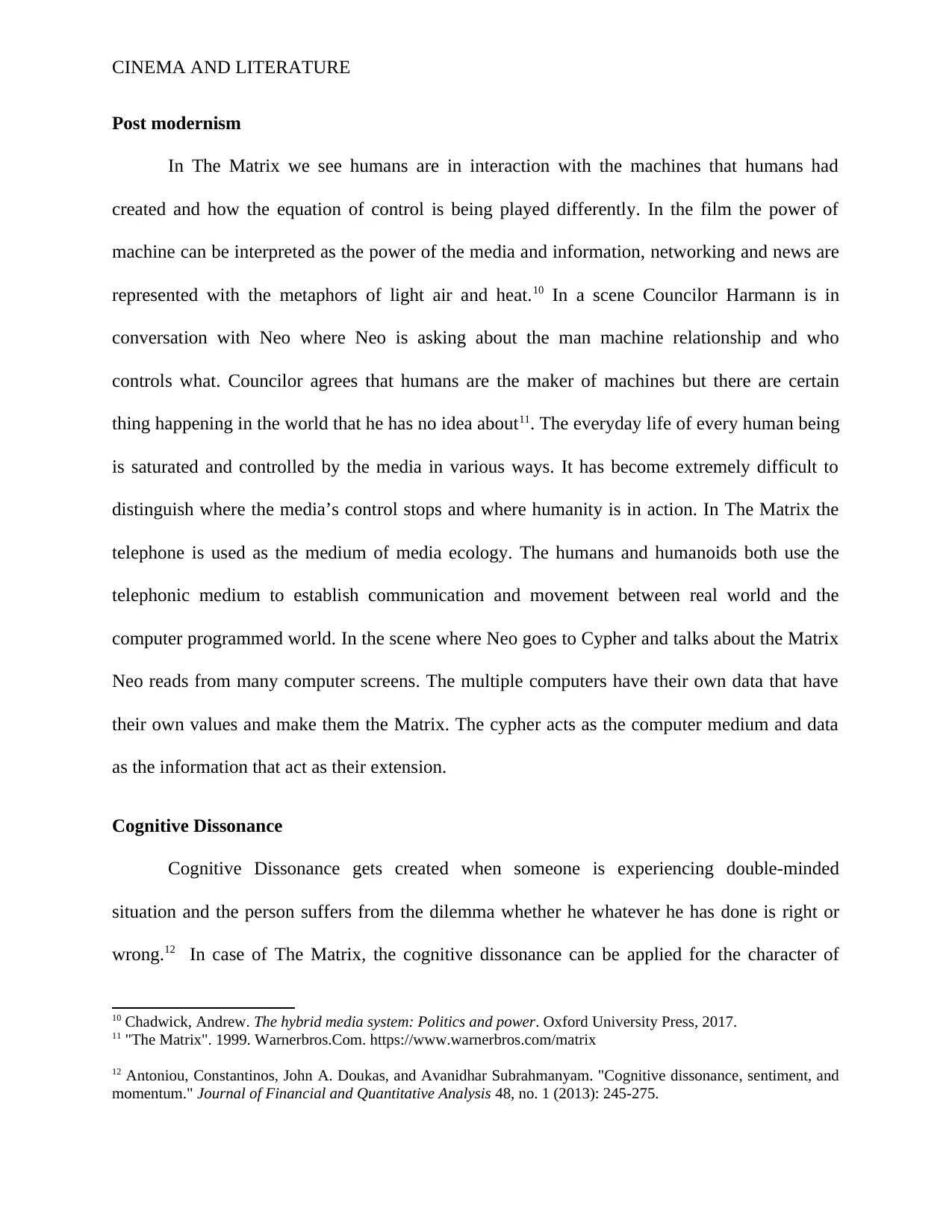
CINEMA AND LITERATURE
Post modernism
In The Matrix we see humans are in interaction with the machines that humans had
created and how the equation of control is being played differently. In the film the power of
machine can be interpreted as the power of the media and information, networking and news are
represented with the metaphors of light air and heat.10 In a scene Councilor Harmann is in
conversation with Neo where Neo is asking about the man machine relationship and who
controls what. Councilor agrees that humans are the maker of machines but there are certain
thing happening in the world that he has no idea about11. The everyday life of every human being
is saturated and controlled by the media in various ways. It has become extremely difficult to
distinguish where the media’s control stops and where humanity is in action. In The Matrix the
telephone is used as the medium of media ecology. The humans and humanoids both use the
telephonic medium to establish communication and movement between real world and the
computer programmed world. In the scene where Neo goes to Cypher and talks about the Matrix
Neo reads from many computer screens. The multiple computers have their own data that have
their own values and make them the Matrix. The cypher acts as the computer medium and data
as the information that act as their extension.
Cognitive Dissonance
Cognitive Dissonance gets created when someone is experiencing double-minded
situation and the person suffers from the dilemma whether he whatever he has done is right or
wrong.12 In case of The Matrix, the cognitive dissonance can be applied for the character of
10 Chadwick, Andrew. The hybrid media system: Politics and power. Oxford University Press, 2017.
11 "The Matrix". 1999. Warnerbros.Com. https://www.warnerbros.com/matrix
12 Antoniou, Constantinos, John A. Doukas, and Avanidhar Subrahmanyam. "Cognitive dissonance, sentiment, and
momentum." Journal of Financial and Quantitative Analysis 48, no. 1 (2013): 245-275.
Post modernism
In The Matrix we see humans are in interaction with the machines that humans had
created and how the equation of control is being played differently. In the film the power of
machine can be interpreted as the power of the media and information, networking and news are
represented with the metaphors of light air and heat.10 In a scene Councilor Harmann is in
conversation with Neo where Neo is asking about the man machine relationship and who
controls what. Councilor agrees that humans are the maker of machines but there are certain
thing happening in the world that he has no idea about11. The everyday life of every human being
is saturated and controlled by the media in various ways. It has become extremely difficult to
distinguish where the media’s control stops and where humanity is in action. In The Matrix the
telephone is used as the medium of media ecology. The humans and humanoids both use the
telephonic medium to establish communication and movement between real world and the
computer programmed world. In the scene where Neo goes to Cypher and talks about the Matrix
Neo reads from many computer screens. The multiple computers have their own data that have
their own values and make them the Matrix. The cypher acts as the computer medium and data
as the information that act as their extension.
Cognitive Dissonance
Cognitive Dissonance gets created when someone is experiencing double-minded
situation and the person suffers from the dilemma whether he whatever he has done is right or
wrong.12 In case of The Matrix, the cognitive dissonance can be applied for the character of
10 Chadwick, Andrew. The hybrid media system: Politics and power. Oxford University Press, 2017.
11 "The Matrix". 1999. Warnerbros.Com. https://www.warnerbros.com/matrix
12 Antoniou, Constantinos, John A. Doukas, and Avanidhar Subrahmanyam. "Cognitive dissonance, sentiment, and
momentum." Journal of Financial and Quantitative Analysis 48, no. 1 (2013): 245-275.
⊘ This is a preview!⊘
Do you want full access?
Subscribe today to unlock all pages.

Trusted by 1+ million students worldwide
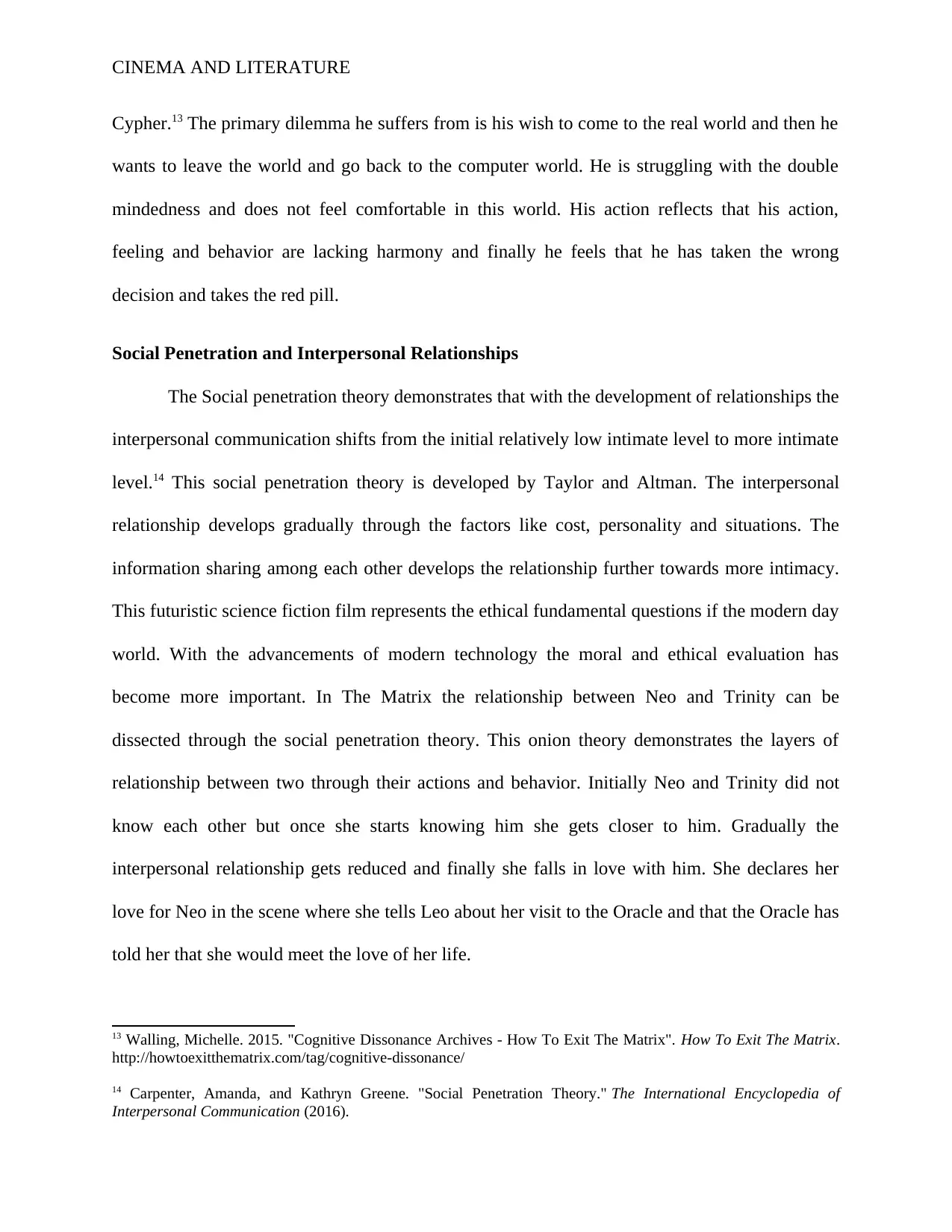
CINEMA AND LITERATURE
Cypher.13 The primary dilemma he suffers from is his wish to come to the real world and then he
wants to leave the world and go back to the computer world. He is struggling with the double
mindedness and does not feel comfortable in this world. His action reflects that his action,
feeling and behavior are lacking harmony and finally he feels that he has taken the wrong
decision and takes the red pill.
Social Penetration and Interpersonal Relationships
The Social penetration theory demonstrates that with the development of relationships the
interpersonal communication shifts from the initial relatively low intimate level to more intimate
level.14 This social penetration theory is developed by Taylor and Altman. The interpersonal
relationship develops gradually through the factors like cost, personality and situations. The
information sharing among each other develops the relationship further towards more intimacy.
This futuristic science fiction film represents the ethical fundamental questions if the modern day
world. With the advancements of modern technology the moral and ethical evaluation has
become more important. In The Matrix the relationship between Neo and Trinity can be
dissected through the social penetration theory. This onion theory demonstrates the layers of
relationship between two through their actions and behavior. Initially Neo and Trinity did not
know each other but once she starts knowing him she gets closer to him. Gradually the
interpersonal relationship gets reduced and finally she falls in love with him. She declares her
love for Neo in the scene where she tells Leo about her visit to the Oracle and that the Oracle has
told her that she would meet the love of her life.
13 Walling, Michelle. 2015. "Cognitive Dissonance Archives - How To Exit The Matrix". How To Exit The Matrix.
http://howtoexitthematrix.com/tag/cognitive-dissonance/
14 Carpenter, Amanda, and Kathryn Greene. "Social Penetration Theory." The International Encyclopedia of
Interpersonal Communication (2016).
Cypher.13 The primary dilemma he suffers from is his wish to come to the real world and then he
wants to leave the world and go back to the computer world. He is struggling with the double
mindedness and does not feel comfortable in this world. His action reflects that his action,
feeling and behavior are lacking harmony and finally he feels that he has taken the wrong
decision and takes the red pill.
Social Penetration and Interpersonal Relationships
The Social penetration theory demonstrates that with the development of relationships the
interpersonal communication shifts from the initial relatively low intimate level to more intimate
level.14 This social penetration theory is developed by Taylor and Altman. The interpersonal
relationship develops gradually through the factors like cost, personality and situations. The
information sharing among each other develops the relationship further towards more intimacy.
This futuristic science fiction film represents the ethical fundamental questions if the modern day
world. With the advancements of modern technology the moral and ethical evaluation has
become more important. In The Matrix the relationship between Neo and Trinity can be
dissected through the social penetration theory. This onion theory demonstrates the layers of
relationship between two through their actions and behavior. Initially Neo and Trinity did not
know each other but once she starts knowing him she gets closer to him. Gradually the
interpersonal relationship gets reduced and finally she falls in love with him. She declares her
love for Neo in the scene where she tells Leo about her visit to the Oracle and that the Oracle has
told her that she would meet the love of her life.
13 Walling, Michelle. 2015. "Cognitive Dissonance Archives - How To Exit The Matrix". How To Exit The Matrix.
http://howtoexitthematrix.com/tag/cognitive-dissonance/
14 Carpenter, Amanda, and Kathryn Greene. "Social Penetration Theory." The International Encyclopedia of
Interpersonal Communication (2016).
Paraphrase This Document
Need a fresh take? Get an instant paraphrase of this document with our AI Paraphraser
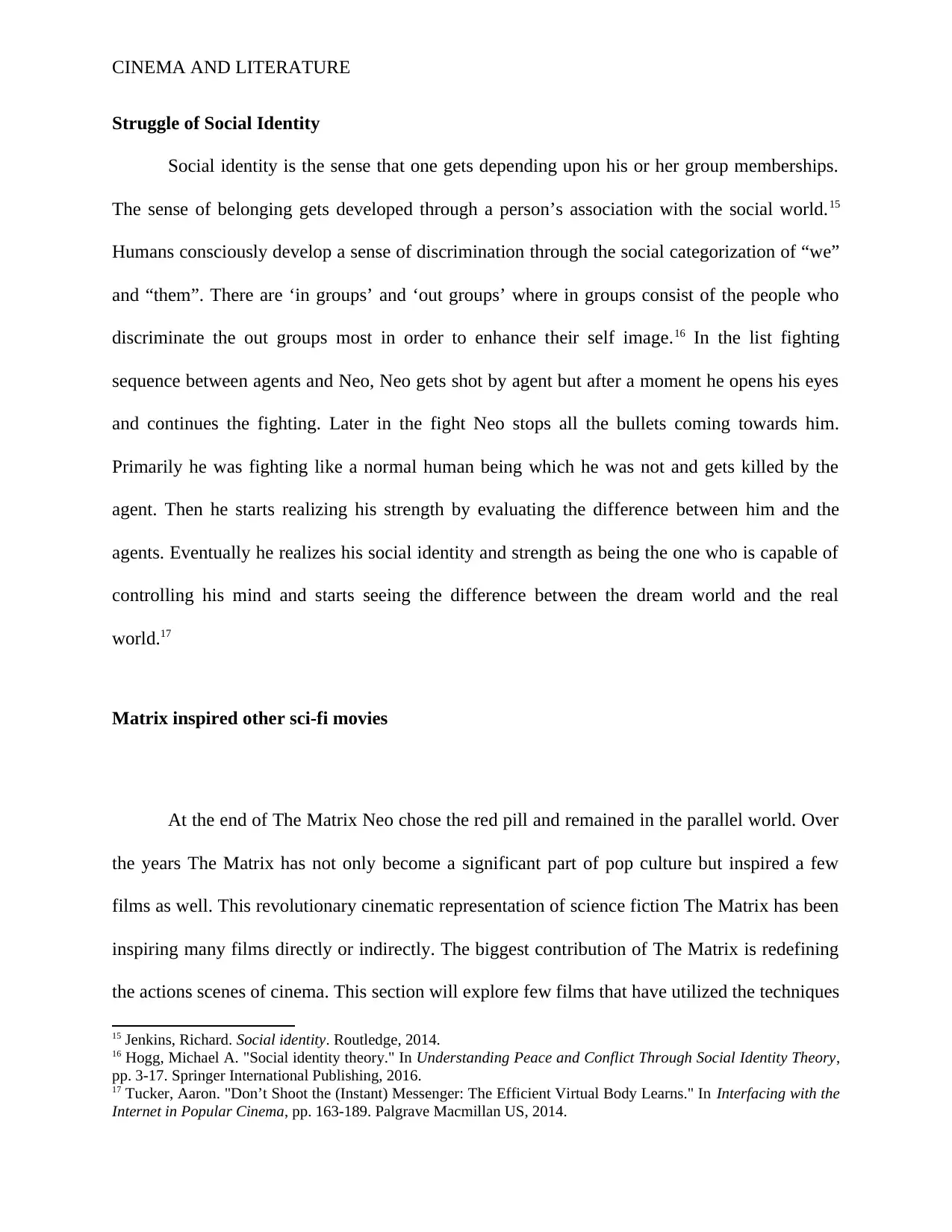
CINEMA AND LITERATURE
Struggle of Social Identity
Social identity is the sense that one gets depending upon his or her group memberships.
The sense of belonging gets developed through a person’s association with the social world.15
Humans consciously develop a sense of discrimination through the social categorization of “we”
and “them”. There are ‘in groups’ and ‘out groups’ where in groups consist of the people who
discriminate the out groups most in order to enhance their self image.16 In the list fighting
sequence between agents and Neo, Neo gets shot by agent but after a moment he opens his eyes
and continues the fighting. Later in the fight Neo stops all the bullets coming towards him.
Primarily he was fighting like a normal human being which he was not and gets killed by the
agent. Then he starts realizing his strength by evaluating the difference between him and the
agents. Eventually he realizes his social identity and strength as being the one who is capable of
controlling his mind and starts seeing the difference between the dream world and the real
world.17
Matrix inspired other sci-fi movies
At the end of The Matrix Neo chose the red pill and remained in the parallel world. Over
the years The Matrix has not only become a significant part of pop culture but inspired a few
films as well. This revolutionary cinematic representation of science fiction The Matrix has been
inspiring many films directly or indirectly. The biggest contribution of The Matrix is redefining
the actions scenes of cinema. This section will explore few films that have utilized the techniques
15 Jenkins, Richard. Social identity. Routledge, 2014.
16 Hogg, Michael A. "Social identity theory." In Understanding Peace and Conflict Through Social Identity Theory,
pp. 3-17. Springer International Publishing, 2016.
17 Tucker, Aaron. "Don’t Shoot the (Instant) Messenger: The Efficient Virtual Body Learns." In Interfacing with the
Internet in Popular Cinema, pp. 163-189. Palgrave Macmillan US, 2014.
Struggle of Social Identity
Social identity is the sense that one gets depending upon his or her group memberships.
The sense of belonging gets developed through a person’s association with the social world.15
Humans consciously develop a sense of discrimination through the social categorization of “we”
and “them”. There are ‘in groups’ and ‘out groups’ where in groups consist of the people who
discriminate the out groups most in order to enhance their self image.16 In the list fighting
sequence between agents and Neo, Neo gets shot by agent but after a moment he opens his eyes
and continues the fighting. Later in the fight Neo stops all the bullets coming towards him.
Primarily he was fighting like a normal human being which he was not and gets killed by the
agent. Then he starts realizing his strength by evaluating the difference between him and the
agents. Eventually he realizes his social identity and strength as being the one who is capable of
controlling his mind and starts seeing the difference between the dream world and the real
world.17
Matrix inspired other sci-fi movies
At the end of The Matrix Neo chose the red pill and remained in the parallel world. Over
the years The Matrix has not only become a significant part of pop culture but inspired a few
films as well. This revolutionary cinematic representation of science fiction The Matrix has been
inspiring many films directly or indirectly. The biggest contribution of The Matrix is redefining
the actions scenes of cinema. This section will explore few films that have utilized the techniques
15 Jenkins, Richard. Social identity. Routledge, 2014.
16 Hogg, Michael A. "Social identity theory." In Understanding Peace and Conflict Through Social Identity Theory,
pp. 3-17. Springer International Publishing, 2016.
17 Tucker, Aaron. "Don’t Shoot the (Instant) Messenger: The Efficient Virtual Body Learns." In Interfacing with the
Internet in Popular Cinema, pp. 163-189. Palgrave Macmillan US, 2014.
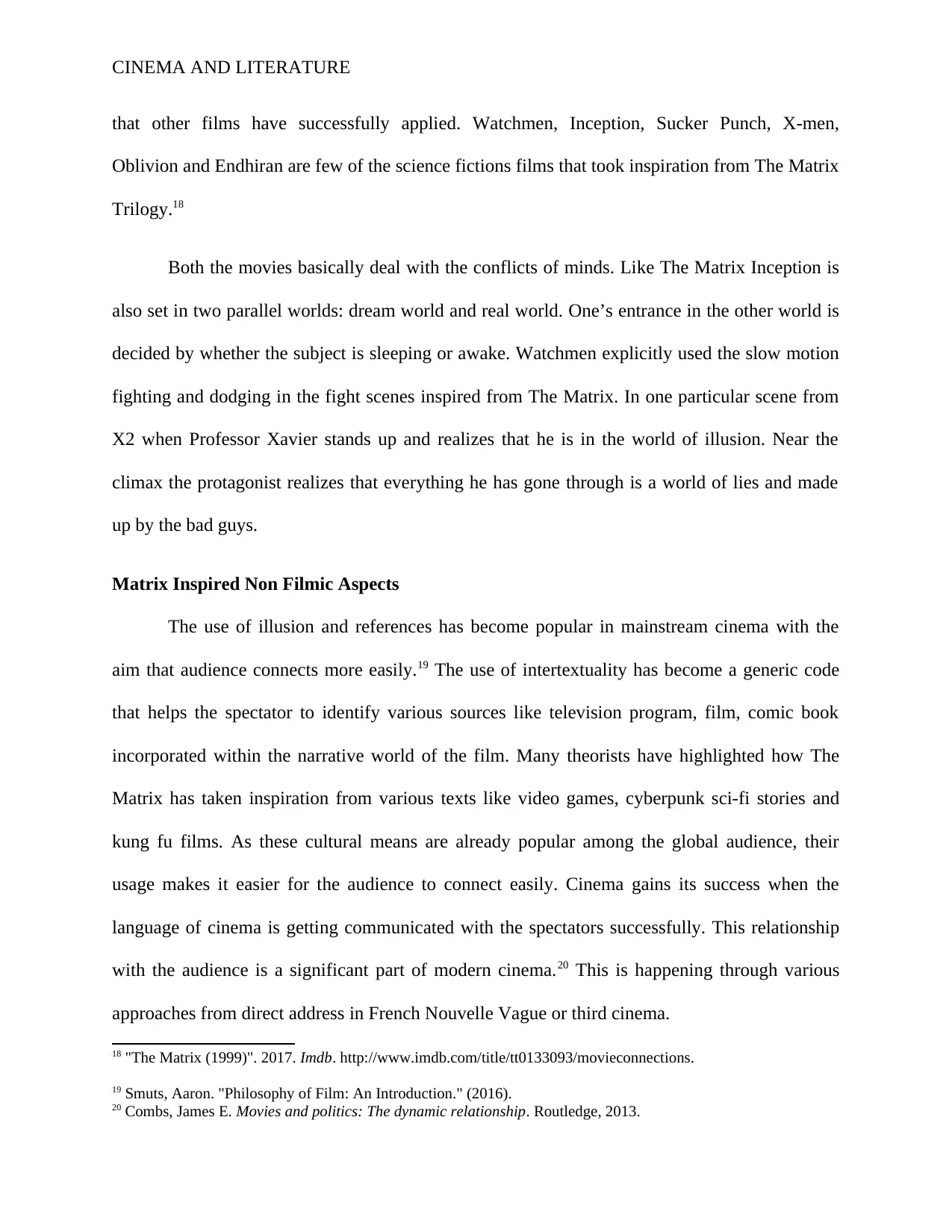
CINEMA AND LITERATURE
that other films have successfully applied. Watchmen, Inception, Sucker Punch, X-men,
Oblivion and Endhiran are few of the science fictions films that took inspiration from The Matrix
Trilogy.18
Both the movies basically deal with the conflicts of minds. Like The Matrix Inception is
also set in two parallel worlds: dream world and real world. One’s entrance in the other world is
decided by whether the subject is sleeping or awake. Watchmen explicitly used the slow motion
fighting and dodging in the fight scenes inspired from The Matrix. In one particular scene from
X2 when Professor Xavier stands up and realizes that he is in the world of illusion. Near the
climax the protagonist realizes that everything he has gone through is a world of lies and made
up by the bad guys.
Matrix Inspired Non Filmic Aspects
The use of illusion and references has become popular in mainstream cinema with the
aim that audience connects more easily.19 The use of intertextuality has become a generic code
that helps the spectator to identify various sources like television program, film, comic book
incorporated within the narrative world of the film. Many theorists have highlighted how The
Matrix has taken inspiration from various texts like video games, cyberpunk sci-fi stories and
kung fu films. As these cultural means are already popular among the global audience, their
usage makes it easier for the audience to connect easily. Cinema gains its success when the
language of cinema is getting communicated with the spectators successfully. This relationship
with the audience is a significant part of modern cinema.20 This is happening through various
approaches from direct address in French Nouvelle Vague or third cinema.
18 "The Matrix (1999)". 2017. Imdb. http://www.imdb.com/title/tt0133093/movieconnections.
19 Smuts, Aaron. "Philosophy of Film: An Introduction." (2016).
20 Combs, James E. Movies and politics: The dynamic relationship. Routledge, 2013.
that other films have successfully applied. Watchmen, Inception, Sucker Punch, X-men,
Oblivion and Endhiran are few of the science fictions films that took inspiration from The Matrix
Trilogy.18
Both the movies basically deal with the conflicts of minds. Like The Matrix Inception is
also set in two parallel worlds: dream world and real world. One’s entrance in the other world is
decided by whether the subject is sleeping or awake. Watchmen explicitly used the slow motion
fighting and dodging in the fight scenes inspired from The Matrix. In one particular scene from
X2 when Professor Xavier stands up and realizes that he is in the world of illusion. Near the
climax the protagonist realizes that everything he has gone through is a world of lies and made
up by the bad guys.
Matrix Inspired Non Filmic Aspects
The use of illusion and references has become popular in mainstream cinema with the
aim that audience connects more easily.19 The use of intertextuality has become a generic code
that helps the spectator to identify various sources like television program, film, comic book
incorporated within the narrative world of the film. Many theorists have highlighted how The
Matrix has taken inspiration from various texts like video games, cyberpunk sci-fi stories and
kung fu films. As these cultural means are already popular among the global audience, their
usage makes it easier for the audience to connect easily. Cinema gains its success when the
language of cinema is getting communicated with the spectators successfully. This relationship
with the audience is a significant part of modern cinema.20 This is happening through various
approaches from direct address in French Nouvelle Vague or third cinema.
18 "The Matrix (1999)". 2017. Imdb. http://www.imdb.com/title/tt0133093/movieconnections.
19 Smuts, Aaron. "Philosophy of Film: An Introduction." (2016).
20 Combs, James E. Movies and politics: The dynamic relationship. Routledge, 2013.
⊘ This is a preview!⊘
Do you want full access?
Subscribe today to unlock all pages.

Trusted by 1+ million students worldwide
1 out of 39
Your All-in-One AI-Powered Toolkit for Academic Success.
+13062052269
info@desklib.com
Available 24*7 on WhatsApp / Email
![[object Object]](/_next/static/media/star-bottom.7253800d.svg)
Unlock your academic potential
Copyright © 2020–2025 A2Z Services. All Rights Reserved. Developed and managed by ZUCOL.